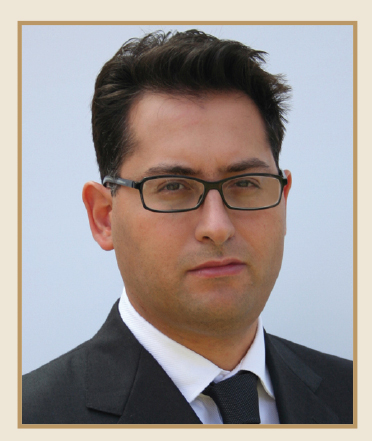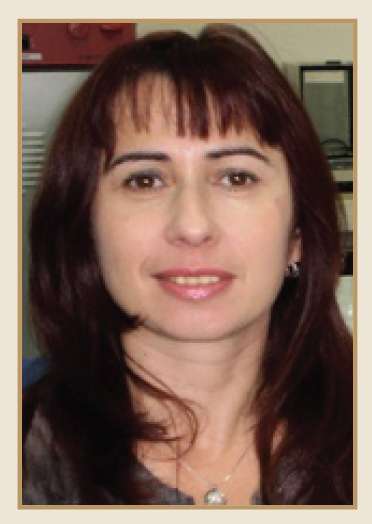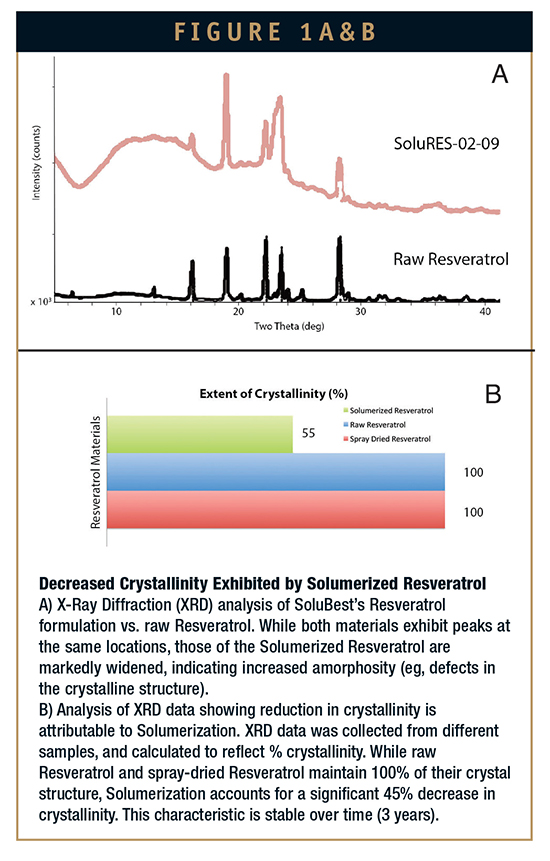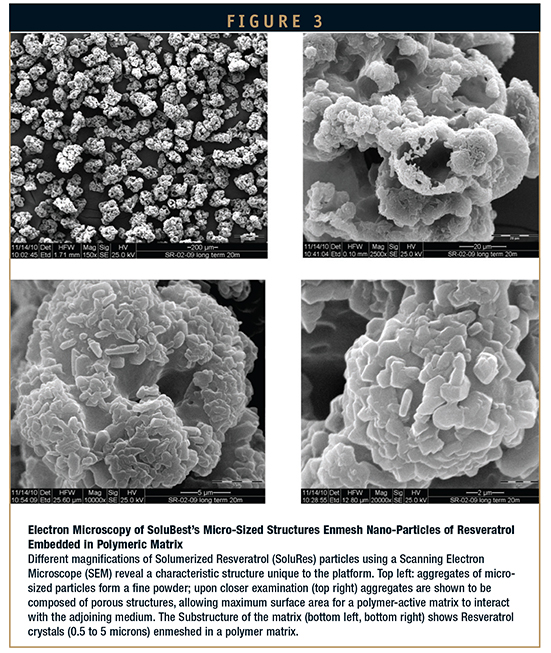Issue:October 2014
FORMULATION DEVELOPMENT - Solumerized(TM) Trans-Resveratrol, Bridging the Bioenhancement Gap to Drug Delivery Between Pharmaceuticals & Dietary Supplements
ABSTRACT
Dietary supplements have been slowing the utlization of cutting-edge drug delivery technologies, mostly as a result of the high unit costs these platforms confer upon the finished products. SoluBest has worked to modify its platform to formulate low-solubility dietary supplements and reports that the resulting products can be competitive in this highly price-sensitive market.
INTRODUCTION
There is no doubt that dietary supplements have become a household item, used by people throughout the world to augment their health and sense of well-being. Indeed, many of the supplements marketed are backed by credible scientific data attesting to their efficacy and ability to prevent the deterioration of health. However, drug delivery technologies have not yet made significant headway in this market, primarily due to cost/benefit considerations. In a market in which cost is a key differentiating factor, supplement manufacturers have been reluctant to invest in cutting-edge delivery technologies that would significantly increase their unit costs; on the other hand, advanced drug delivery platforms are rarely designed with reducing unit costs in mind. The result is that apart from some non-proprietary micronization techniques, supplements – even those with low bioavailability – are rarely formulated using the technologies that can truly boost their performance. A new generation of delivery technologies, exemplified in this article by SoluBest’s Solumer technology, is poised to change this by enhancing the bioavailability of numerous active ingredients using easily formulated, proven, and perhaps most importantly, cost-effective delivery technologies capable of significantly enhancing the bioperformance of select botanical extracts.
In this article we will discuss the example of Resveratrol, a supplement with a solid body of scientific data attesting to its efficacy in enhancing lifespan and treating a variety of medical conditions (heart diseases, diabetes, cancer, etc), which yet remains short of its true market potential due to stability, bioavailability, and cost issues.
RESVERATROL: STILL AN ANTI-AGING PARADIGM CHANGE
Resveratrol is a super-antioxidant, which helps combat heart disease, diabetes and cancer, helps to lower blood cholesterol, and is useful in diseases accompanied by inflammation. Resveratrol was discovered in the late 1990s as part of the investigation into the French Paradox – the discrepancy between the French’s low rate of cardiovascular diseases and the typical French diet, which is high in saturated fats. Focusing on components present in red wine, researchers isolated Resveratrol and identified its beneficial effects on the health and life-prolonging activities in animal models. It has been also determined that Resveratrol exerts these effects via activation of Sirtuin proteins, molecules that prevent cellular aging and inflammation.1 Since then, efforts have been made to translate these findings from animal to human clinical models, while various companies have tried to tap the commercial potential of this promising supplement.
As is the case with all other actives, the beneficial effects of Resveratrol (and of active ingredients in other supplements) are governed not by its dose strength, but by its actual bioavailability. For Resveratrol, an unstable molecule with extremely low solubility, delivery into the bloodstream is a significant challenge. To overcome its inherent bioavailability issues, Resveratrol is commonly marketed in dosages up to 500 mg per capsule or tablet. Different products contain 30% to 99% pure Trans-Resveratrol, with higher purity commanding higher prices. However, a number of significant obstacles stand between raw Resveratrol and a highly bioavailable supplement – even one that contains a high dose of raw material.
First and foremost, Resveratrol has been shown to be quite unstable. Any preparation of Resveratrol typically contains the two common forms of the molecule: the cis- and the Trans-Resveratrol variants, with the cis-variant being more stable than the trans-variant. This results in the rapid degradation of Trans-Resveratrol into cis-Resveratrol. Unfortunately, only the less stable transvariant is biologically active. This degradation is rapid and well documented: Rossi et al. reported that there is a significant decline in the content of Trans-Resveratrol in a number of products during the products shelf-life – up to 55% less than the stated amount.2
Second, Resveratrol is characterized by low bioavailability, and only a small fraction of it reaches the blood. For example, Brown et al reported Cmax levels of Resveratrol following administration of 500-mg daily doses for a minimum of 21 days to be only about 43.8 micrograms per liter of blood.3 When calculated together with the quantities of Resveratrol’s most common metabolites, this amount rises to approximately 0.97 mg/L, equating to an extremely low rate of absorption. This extremely low bioavailability is a result of Resveratrol’s hydrophobicity and highly ordered crystalline structure, which prevents its dissolution in the GI tract and subsequent absorption, as well as the rapid breakdown of the molecule in the liver after absorption (it is important to remember, however, that there is evidence that some of Resveratrol’s therapeutic effects are actually exerted by its metabolites).4 The issue is compounded by repeated observations that Resveratrol only has discernable effects if a consistently high level of blood Resveratrol is maintained.5
As noted previously, the most common approach has been to administer high amounts of Resveratrol in order to exert any biological effect. However, this approach is hampered by the unpleasant side effects exerted by the unabsorbed Resveratrol remaining in the GI tract, which increase as larger amounts of Resveratrol remain unabsorbed.3,4
Supplement manufacturers have attempted to solve these issues in a number of ways. The trans-to-cis transformation issue has been addressed by certain manufacturers by the introduction of synthetic 99% pure Trans-Resveratrol which is supposed to retain its stability significantly better than plant-derived variants. This approach, however, does little to improve the compound’s inherently low bioavailability. To this end, certain manufacturers have attempted to enhance Resveratrol’s solubility characteristics by converting it into micro-sized particles. While this approach undoubtedly results in a certain bioavailability advantage over the unformulated compound, an approach championed by the drug delivery company SoluBest manages to bypass all the obstacles noted previously using a focused formulation approach.
A NOVEL DRUG DELIVERY PLATFORM APPLIED TO SUPPLEMENTS
Solumer, SoluBest’s drug delivery platform manages to bypass the limitations posed by a wide spectrum of bioavailability- and stability-challenged compounds. It is amenable to a wide variety of oral dosage forms, yet remains a cost-effective alternative to other, less advanced formulation techniques.
Scientific Rationale
Bioactive substances can be classified according to their physical forms. Some are liquid (or dissolved in liquid) and can be administered orally or injected. Others are commonly solids, and these can be classified further according to the arrangement of the bioactive material’s molecules. Thus, amorphous solids lack a crystalline structure, are dissolved readily in biological fluids, and hence tend to be highly bioavailable. On the other hand, commercially formulating amorphous solids can be extremely challenging as they tend to be quite unstable.
On the other end of the spectrum are the crystalline bioactive solids. These tend to be highly stable with generally very good shelf-lives, yet the crystalline structure that contributes to their stability also hampers their dissolution and results in relatively low bioavailability. As can be seen in Figure 1 and Table 1, SoluBest developed its Solumer platform with the intention of creating a semi-amorphous/semi-crystalline interim state that allows its formulations both to maintain stability and to be very soluble, leading to enhanced bioavailability.
Solumerization achieves this by engineering particles consisting of a matrix using approved-for-food and safe-forhuman use polymer building blocks together with the active compound, in this case Resveratrol. The polymers and active material are rapidly flash-dried, and during this drying step, submicron particles with a novel disordered semi-crystalline conformation are created. These particles are locked into the matrix, ensuring both enhanced solubility as seen in Figure 1 (due to the small particle size and the disordered crystal structure) and stability (due to maintenance of some degree of the same crystal structure). Moreover, as SoluBest’s platform was developed with the elimination of the food effect in mind, the experiment depicted in Figure 2 shows equal solubility is obtained both in simulated fed and fasted conditions (see legend). As previously mentioned, fed conditions refer to a high fat meal prior to ingestion – a somewhat counterproductive approach in the case of Resveratrol.
Figure 3 shows the unique Resveratrol submicron structures created by the SoluBest’s platform. When dry, the particles constitute a powder that could be easily converted into a variety of dosage forms familiar to consumers (capsules, tablets, and sachets). However, upon contact with gastric fluids, the unique structures readily disintegrate into highly bioavailable colloidal dispersions.
Clinical Trials
Critically, the real advantages of Solumer-formulated Resveratrol, SoluRes, are apparent when comparing its bioavailability to other formulations, and certainly to the commonly sold raw material.
First, the stability of the formulation plays a critical role once the formulation is ingested. Clinical testing using SoluRes indicates that the active ingredient reaches the blood in the form of Trans-Resveratrol or of its characteristic metabolites.
Moreover, the amount of Resveratrol actually taken up into the blood is far superior to any Resveratrol product currently available. In a two-way crossover randomized trial in 12 healthy volunteers, SoluRes showed a five-fold increase in Cmax (the maximum amount absorbed in the blood) of Resveratrol and its metabolites, compared to micronized Resveratrol.
Simply put, the 500-mg dose of SoluRes used in the trial exhibited bioavailability much higher than the equivalent amount of micronized Resveratrol, with Trans-Resveratrol bioavailability (after a single administration) reaching on average 407 micrograms/L. The Cmax values for SoluRes (407 micrograms/L of Trans-Resveratrol) were roughly five times the Cmax levels exhibited by the micronized control, and nine times higher Cmax as compared to the same dose administered in the study by Brown et al.3 These results are even more striking given that in the study by Brown et al. daily doses of Resveratrol were given to the participants, and accumulation of the active compound and its metabolites in the body could have occurred. In contrast, a single dose of Reservatrol (SoluRes) was given to thepatients in the SoluBest study (Table 2). Morover, when comparing the data collected by Brown et al., it is clear that the enhancement in bioavailability using the Solumer platform makes the amount administered on par with a 5-g daily dose. Extrapolating from these results to other products, we believe it is safe to conclude that SoluRes is bioavailable at least four to ten times more than unformulated Resveratrol following a single-dose administration; this advantage can be expected to be even more pronounced under conditions of repeated dosing.
BRIDGING THE BIOENHANCEMENT GAP TO DIETARY SUPPLEMENTS
While SoluBest’s technology is one of a number of nano-formulation technologies capable of enhancing solubility, unlike other technologies, it was designed with mass market cost-sensitive products in mind. Thus, the platform utilizes off-the- shelf polymers available in both food and pharma grades and uses spray-drying, a technology common to the food additive and supplement industry. The resulting powder is easy to handle and can be readily converted into tablets, capsules, and sachets. Moreover, as in the case of Resveratrol, in itself an expensive supplement (raw API can exceed $600/kg), the platform allows manufacturers to use less API while reaching the same efficacy.
It is estimated that using full-scale spray-dryers, combined with solvent collection and recycling, allows the platform to be implemented at a cost of less than $100/kg of API. While low-cost supplements probably benefit less from such the added price premium, the implementation of the platform toward supplements like Resveratrol with its concomitant enhancement in bioavailability results in a formulation with a unique value-for-money proposition. While the measure is unconventional, the cost per unit absorbed using SoluBest’s platform is lower than almost any other Resveratrol product currently on the market.
To view this issue and all back issues online, please visit www.drug-dev.com.
REFERENCES
1. Basil P, Hubbard AP, Gomes, HD, et al. Evidence for a Common Mechanism of SIRT1 Regulation by Allosteric Activators;Sinclair Science. March 8, 2013:1216-1219.
2. Rossi D, Guerrini A, Bruni R, et al. Trans-Resveratrol in nutraceuticals: issues in retail quality and effectiveness. Molecules. 2012;17:12393-12405.
3. Brown V, Patel KR, Viskaduraki M, et al. Repeat dose study of the cancer chemopreventive agent resveratrol in healthy volunteers: safety, pharmacokinetics, and effect on the insulin-like growth factor axis. Cancer Res. 2010;70:9003-9011.
4. Smoliga J, Baur JA, Hausenblas HA. Resveratrol and health – a comprehensive review of human clinical trials. Mol Nutr Food Res. 2011;55:1129-1141.
5. Vang O, Ahmad N, Baile CA, et al. What is new for an old molecule? systematic review and recommendations on the use of resveratrol. 2011. PLoS ONE 6(6): e19881. doi:10.1371/journal.pone.0019881.
6. Smolinga JM, Vang O, Baur JA. Challenges of translating basic research into therapeutics: resveratrol as an example. J Gerontol A Biol Sci Med Sci. 2012;67A(2):158-167.

Dr. Amir Zalcenstein is an independent consultant specializing in NTE projects. Previously, he was Head of Business Development at BiondVax Pharmaceuticals, CEO of Amorphical Ltd. and SoluBest Ltd., and co-founded Targia Ltd., a reformulation company specializing in the CNS space. He earned his MBA from the Technion and his PhD from the Weizmann Institute.

Dr. Galia Temstin Krayz directs SoluBest’s Formulation R&D, its analytical method development, process optimization, and scale-up. She earned her PhD in Organic and Material Chemistry from Ben Gurion University in Beer Sheva, Israel, and has specialized in self-assembly nano-delivery systems from Division of Material Chemistry, at the Chemical Department, at the University of Toronto, Canada. She has both academic and industrial experience in organic synthesis and process development of APIs in Perrigo (Chemagis, Israel).

Dr. Sabina Glozman returned to SoluBest after managing Biological Industries Ltd. since 2008. Previously, Dr. Glozman served as CEO at Vecta Pharmaceuticals and VP, Business Development at Protalix, among other companies. She has also founded a number of life-science start-up ventures, including Accelta Ltd. (a spin-off of from the Technion), as well as other projects from Ben Gurion University, the Israel National Institute of Biotechnology, and Haifa University. Dr. Glozman is a graduate of the Hebrew University in Jerusalem and has earned her PhD at the Weizmann Institute of Science’ Neurochemistry Department.
Total Page Views: 4634















